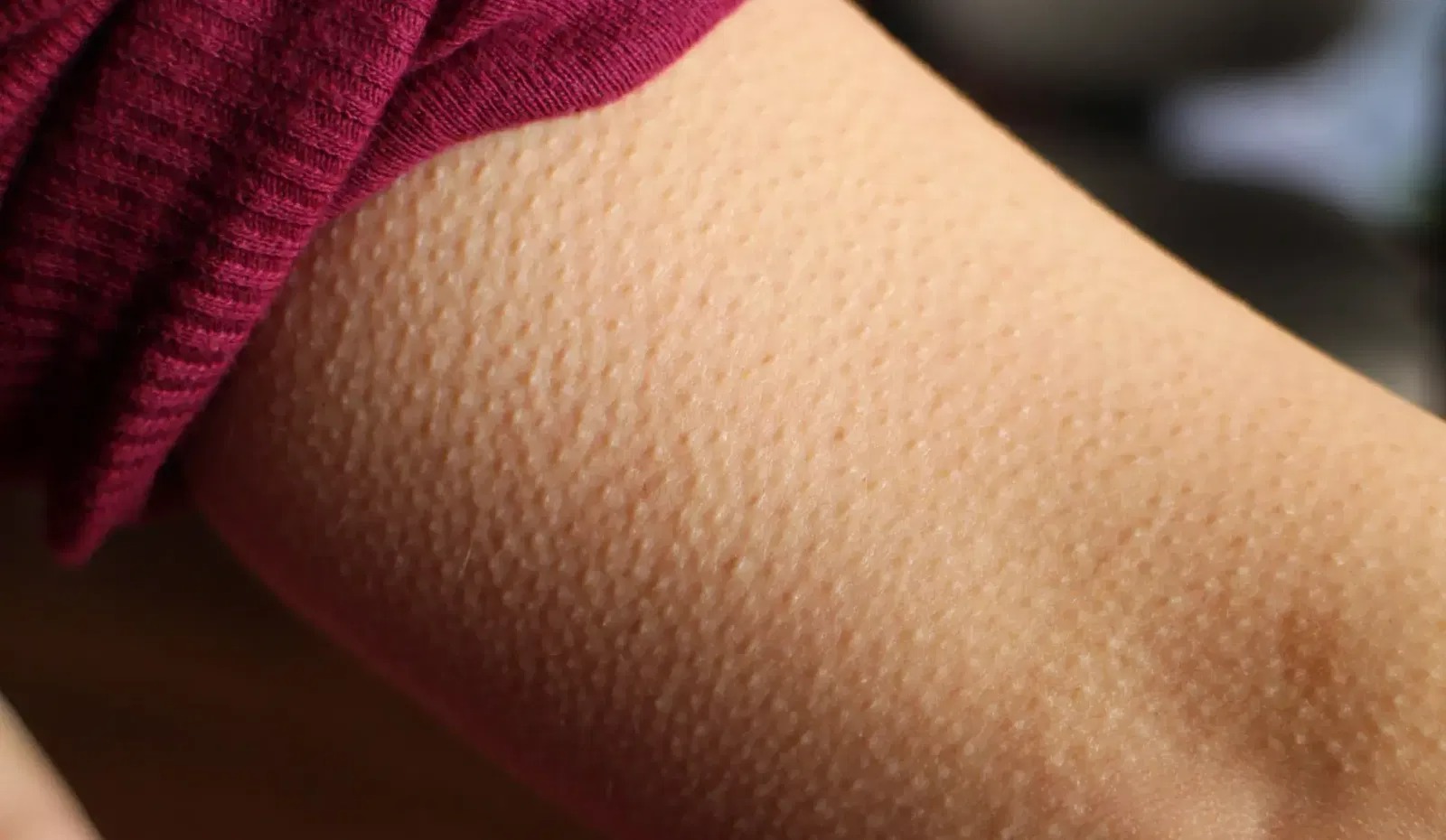Goosebumps are a common physiological response characterized by the temporary erection of tiny hairs on the skin. This reaction occurs when small muscles at the base of hair follicles—called arrector pili muscles—contract. Medically known as piloerection or cutis anserina, goosebumps are generally harmless and are triggered by various stimuli, including cold temperatures and strong emotions.
According to the Cleveland Clinic, goosebumps are an involuntary reflex mediated by the autonomic nervous system, which controls many of the body’s unconscious functions such as heart rate and digestion. This article explores why goosebumps occur, what’s considered normal, and when they might signal an underlying health issue that warrants medical evaluation.
What Causes Goosebumps?
1. Exposure to Cold
One of the most common and well-understood triggers for goosebumps is cold weather. When your body detects a drop in temperature, the sympathetic nervous system releases neurotransmitters like norepinephrine, causing the arrector pili muscles to contract. This reflex aims to trap a layer of air close to the skin, providing minimal insulation—a vestigial evolutionary feature more useful in fur-covered animals than in humans.
Source: Mayo Clinic – “Why do we get goose bumps?”
2. Emotional Responses
Goosebumps can also be elicited by intense emotional experiences. Strong feelings such as fear, awe, nostalgia, or excitement can activate the “fight-or-flight” response, releasing adrenaline. This can happen while listening to moving music, watching a suspenseful film, or recalling vivid memories.
Source: Harvard Medical School – “The fight-or-flight response”
3. Reflexive Reactions
Sudden scares or shocking situations may cause a surge in adrenaline. This prepares the body to respond quickly to threats—a survival mechanism inherited from our evolutionary ancestors. Even though modern humans don’t rely on bristling fur to appear larger to predators, the reflex remains.
Source: Britannica – “Piloerection”
When Goosebumps Might Indicate a Medical Condition
While goosebumps are usually harmless, experiencing them frequently without clear triggers might sometimes point to underlying health conditions. Below are some medically recognized scenarios where unexplained or persistent goosebumps may be relevant.
1. Neurological Disorders
The autonomic nervous system controls involuntary bodily functions, including the reflexes that cause goosebumps. Certain neurological conditions may disrupt this system’s normal functioning.
Examples include:
-
Epilepsy: Some focal seizures, called autonomic seizures, can involve piloerection as a symptom, along with other signs such as sweating or gastrointestinal sensations.
-
Multiple Sclerosis (MS): Damage to the nervous system can lead to varied sensory symptoms, including tingling or unexplained goosebumps.
Source: Epilepsy Foundation – “Autonomic Seizures”
Source: National Multiple Sclerosis Society – “Symptoms & Diagnosis”
2. Seizure Activity
In rare cases, goosebumps can be a symptom of a type of seizure known as a piloerection seizure. These seizures originate in parts of the brain that regulate autonomic functions and may cause chills or goosebumps without convulsions.
If you experience additional symptoms such as confusion, blackouts, or muscle twitching, seek evaluation by a healthcare professional.
Source: Epilepsy Foundation
3. Hormonal Disorders
Certain conditions affecting the adrenal glands can result in elevated levels of catecholamines (like adrenaline). A rare example is pheochromocytoma, a tumor of the adrenal glands, which may cause:
-
Sudden episodes of high blood pressure
-
Palpitations
-
Excessive sweating
-
Unexplained goosebumps
Such conditions are uncommon but medically documented.
Source: National Institutes of Health (NIH) – “Pheochromocytoma and Paraganglioma”
4. Anxiety and Stress
Psychological stress and anxiety can provoke physical reactions. Even in the absence of an immediate emotional trigger, chronic stress can sustain elevated levels of stress hormones such as cortisol and adrenaline. This can lead to:
-
Sweating
-
Shaking or tremors
-
Rapid heartbeat
-
Occasional goosebumps
Mental health professionals can help manage these symptoms through therapy, lifestyle changes, or medications.
Source: American Psychological Association – “Stress Effects on the Body”
5. Skin Conditions
Certain skin conditions may resemble persistent goosebumps:
-
Keratosis Pilaris: This common condition causes small, rough bumps on the skin, typically on the arms, thighs, or cheeks. While these bumps are often mistaken for chronic goosebumps, they result from keratin buildup in hair follicles.
Keratosis pilaris is benign but may be managed with moisturizing treatments and exfoliating agents.
Source: American Academy of Dermatology – “Keratosis Pilaris”
When Should You See a Doctor?
While goosebumps are usually harmless, you should consider consulting a healthcare provider if you experience:
-
Goosebumps occurring frequently without identifiable triggers
-
Neurological symptoms such as numbness, tingling, confusion, or weakness
-
Signs of hormonal imbalance (e.g., unexplained high blood pressure, palpitations)
-
Severe or worsening anxiety symptoms
A medical professional can perform a thorough history and physical examination. They may recommend tests to evaluate neurological function, hormone levels, or skin health to identify any underlying causes.
Source: Mayo Clinic – “Goose bumps”
How Are Underlying Causes Diagnosed?
If your doctor suspects an underlying condition, they may suggest:
-
Neurological examination or imaging to check for seizure disorders
-
Blood tests to evaluate hormone levels, including catecholamines
-
Skin examination or biopsy if a dermatological condition is suspected
-
Psychological evaluation to assess for anxiety or stress disorders
These diagnostic approaches help ensure appropriate treatment or management.
Managing Goosebumps at Home
For most people, goosebumps don’t require any treatment. However, you can try:
-
Staying warm in cold environments with layered clothing
-
Practicing relaxation techniques like deep breathing to reduce stress
-
Using gentle skincare routines if keratosis pilaris is a concern
Final Thoughts
Goosebumps are a normal, often harmless reaction to cold temperatures or strong emotions. They are part of the body’s autonomic response system, designed to protect and alert us. However, if you notice goosebumps appearing frequently without clear causes, or if they occur alongside other symptoms, it’s wise to consult a healthcare professional. Early evaluation can help rule out or address underlying neurological, endocrine, or psychological conditions.
By understanding the range of causes—from everyday responses to medical conditions—you can take informed steps toward maintaining your health and well-being.
References
-
Cleveland Clinic. “Goosebumps: What They Are & Why You Get Them.”
-
Mayo Clinic. “Goose bumps.”
-
Epilepsy Foundation. “Autonomic Seizures.”
-
National Multiple Sclerosis Society. “Symptoms & Diagnosis.”
-
National Institutes of Health. “Pheochromocytoma and Paraganglioma.”
-
American Academy of Dermatology. “Keratosis Pilaris.”
-
American Psychological Association. “Stress Effects on the Body.”
-
Harvard Medical School. “The fight-or-flight response.”
-
Britannica. “Piloerection.”


